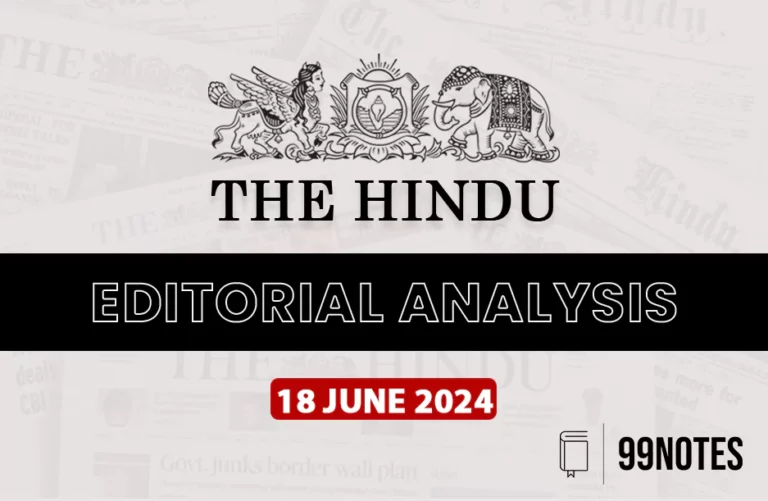4 May 2024 : The Hindu Editorial Notes PDF
1. The paradox of India’s global rise, its regional decline
| Topic: GS2 – International Relations |
| Context: |
| ● The article discusses the paradoxical nature of India’s foreign policy, where its global rise contrasts with a decline in regional influence, primarily due to China’s ascendance in South Asia.
● Despite India’s growing power and participation in global forums, its ability to assert dominance in its immediate neighbourhood has weakened. ● The article proposes strategic shifts and leveraging of soft power to navigate this complex geopolitical landscape effectively. |
Introduction: Understanding the Paradox
- The paradox of India’s contemporary foreign policy lies in its global rise amid regional decline, attributed to changes in relative power dynamics, particularly vis-à-vis China, and shifting geopolitical landscapes in South Asia.
India’s Global Rise
- India’s aggregate power has surged in the last two decades, evident in economic growth, military capabilities, and global recognition through participation in key forums like the G-20 and the Quad.
| G-20 and The QUAD |
| G-20:
● The Group of Twenty (G-20) is an international forum for the governments and central bank governors from 19 countries and the European Union. ● Established in 1999 in response to the financial crises of the late 1990s, it aims to discuss policy issues pertaining to the promotion of international financial stability. ● Member countries represent major economies, including the United States, China, India, Japan, Germany, and others. ● G-20 summits are held annually, providing a platform for leaders to address global economic challenges and coordinate policy responses. ● Topics discussed include trade, development, climate change, and sustainable development goals. ● The G-20 accounts for around 80% of global GDP and two-thirds of the world’s population, making it a significant forum for global economic governance. QUAD (Quadrilateral Security Dialogue): ● The QUAD is an informal strategic forum comprising the United States, Japan, India, and Australia. ● Formed in 2007 and revived in 2017, it aims to promote a free, open, and inclusive Indo-Pacific region. ● Member countries share common values and concerns regarding maritime security, regional stability, and the rise of China. ● The QUAD conducts consultations and joint exercises to enhance cooperation on security and defence issues. ● It seeks to uphold international rules-based order and address common challenges such as terrorism, piracy, and natural disasters. ● The QUAD serves as a platform for diplomatic engagement and coordination among like-minded democracies in the Indo-Pacific region. |
- Its inclusion in multilateral groups underscores its geopolitical significance, especially in the Indo-Pacific, where India holds a central position.
- The international community, except China, increasingly accommodates India’s aspirations for global leadership.
Regional Decline and Extraneous Factors
- However, India’s influence in South Asia has weakened compared to the Cold War era, exacerbated by China’s ascendance in the region and the United States’ withdrawal.
- The region’s smaller powers engage in balancing acts, viewing China as a hedge against India, shifting the regional balance of power.
Impact of China’s Rise
- China’s emergence as a regional superpower poses the most significant challenge to India’s influence in South Asia.
- India faces heightened geopolitical competition in its neighbourhood, leading to strategic shifts among smaller powers aligning with China.
Revisiting India’s Strategy
- India must acknowledge the changing geopolitical landscape and modernise its approach to the region.
- Focusing on its strengths, such as cultural ties, and engaging with the maritime Indo-Pacific to counterbalance continental challenges are vital strategies.
- Embracing a non-India centric lens and leveraging partnerships with external actors can address regional challenges.
Utilizing Soft Power and Informal Diplomacy
- India should harness its soft power to maintain influence, fostering informal contacts and conflict management processes in the region.
- Encouraging informal engagements with civil society actors can bridge diplomatic gaps, especially in sensitive areas like Myanmar.
| What is soft power of a country? |
| Soft Power of a Country:
● Soft power refers to a nation’s ability to influence others through culture, values, and diplomatic initiatives rather than military or economic coercion. ● It includes elements like cultural exports, diplomacy, education, and global leadership in various fields. ● Soft power enhances a country’s reputation, fosters international cooperation, and strengthens diplomatic ties. ● It complements traditional power resources and promotes goodwill and positive perceptions abroad. Soft Power of India: ● .Cultural Richness: Bollywood, Yoga, Ayurveda, and diverse cuisine. ● Historical Legacy: Ancient civilization, philosophy, and spirituality. ● Diplomacy: Non-alignment, peacekeeping efforts, and global advocacy. ● Education: Growing importance of Indian universities and diaspora. ● Economic Growth: Emerging market status and entrepreneurial spirit. ● Technology: IT industry prowess and space exploration endeavours. ● Diversity: Unity in diversity, showcasing pluralism and tolerance. |
Implications for India’s Global Aspirations
- The paradox raises questions about India’s ability to maintain global leadership if it fails to assert primacy in its immediate neighbourhood.
- Addressing the paradox requires a nuanced approach balancing regional concerns with global ambitions.
Conclusion: Navigating the Paradox
- India’s foreign policy must navigate the complexities of its global rise and regional decline by adapting strategies to shifting power dynamics and leveraging soft power to maintain influence in its neighbourhood.
| Conflicts with neighbourhood countries and India |
| Myanmar:
● India’s relationship with Myanmar is generally positive, focusing on security cooperation, counterinsurgency efforts, and economic ties. ● However, India faces challenges related to the Rohingya refugee crisis, as Myanmar’s handling of the minority Rohingya population has drawn international criticism. ● India balances its support for Myanmar’s democratic transition with concerns over human rights violations and instability in the region. Maldives: ● India-Maldives relations have experienced fluctuations due to political turmoil and shifts in leadership. ● The Maldives’ growing engagement with China has strained ties with India. ● India intervened diplomatically to support democratic institutions and stabilise the political situation during times of crisis. ● The social media spat exposed deeper issues. The Maldives’ new president has called for a more independent foreign policy, including potentially reducing Indian military presence and increasing ties with China. Sri Lanka: ● India-Sri Lanka relations have been influenced by the ethnic conflict in Sri Lanka, particularly regarding the Tamil minority. ● India’s intervention in the Sri Lankan Civil War and subsequent peacekeeping efforts strained relations with the Sri Lankan government. ● China’s increasing influence in Sri Lanka, particularly through infrastructure projects like the Hambantota Port, poses challenges for India’s strategic interests in the region. ● Efforts to improve ties include economic cooperation, cultural exchanges, and addressing concerns related to regional security. Afghanistan: ● India-Afghanistan relations are primarily focused on development assistance, infrastructure projects, and counterterrorism efforts. ● The Taliban insurgency and Pakistan’s support for militant groups in Afghanistan pose security challenges for both India and Afghanistan. ● India’s role in Afghanistan’s reconstruction and efforts to build diplomatic ties has been met with opposition from Pakistan. ● Despite these challenges, India remains committed to supporting Afghanistan’s stability and development. Nepal: ● India and Nepal have historical and cultural ties, but disputes over border territories strain relations. ● Nepal’s objection to India’s construction of the Lipulekh Pass road and the Kalapani region led to diplomatic tensions. ● Nepal’s constitutional amendments also sparked concerns in India regarding the rights of the Madhesi community. ● Efforts to address grievances and maintain goodwill are ongoing, but periodic strains persist. Bangladesh: ● India-Bangladesh relations have significantly improved in recent years, marked by cooperation in trade, security, and connectivity. ● Historic issues like the sharing of river waters, particularly the Teesta River, remain unresolved but are being addressed through dialogue. ● Both countries collaborate closely on issues like counterterrorism and regional stability. ● Bilateral ties are generally positive, with efforts to address outstanding issues through mutual understanding and cooperation. |
| PYQ: The diverse nature of India as a multi religious and multi-ethnic society is not immune to the impact of radicalism which has been in her neighbourhood. Discuss along with the strategies to be adopted to counter this environment. (200 words/12.5m) (UPSC CSE (M) GS-3 2014) |
| Practice Question: How does the paradoxical nature of India’s foreign policy, marked by a global rise and regional decline, impact its aspirations for global leadership? Discuss potential strategies to address this paradox. (150 Words /10 marks) |
2. This is the year to get the SDG goals back on track
| Topic: GS2 – Governance, GS2 – Social Justice – Development and management of social sector/services, GS3 – Indian Economy – Inclusive growth. |
| Context |
| ● The article discusses the state of progress towards achieving the Sustainable Development Goals (SDGs) outlined in the UN’s Agenda 2030.
● Despite global commitments, slow progress and neglect of environmental goals threaten sustainability efforts. ● With 2024 being an election year in many countries, the article calls for policymakers to prioritise sustainability and align national policies accordingly. |
Introduction: The State of Sustainable Development Goals (SDGs)
- The United Nations summit on Sustainable Development Goals (SDG) in New York reviewed progress towards achieving the Agenda 2030, comprising 17 SDGs with 169 targets.
- Despite commitments from all countries, progress remains slow, exacerbated by the COVID-19 pandemic and neglect of environmental goals.
- The lack of integrated approaches to SDGs threatens global efforts towards sustainability.

Slow Progress and Concerns
- Progress towards SDGs has been inadequate, with reports indicating off-track performance from 2015 to 2019.
- Global crises, especially the COVID-19 pandemic, have impeded advancements, particularly in environmental and biodiversity goals.
- Pursuing SDGs in isolation undermines their interconnected nature, risking accelerated environmental degradation and compromising sustainability objectives.
Key Areas for Urgent Action
- The UN SDG Report 2023 identified five critical areas for immediate attention:
- Governments committing to accelerated, sustained actions towards SDGs.
- Implementing integrated policies to eradicate poverty, reduce inequality, and protect the environment.
- Strengthening national and subnational capacities and accountability.
- International community mobilizing resources for developing nations.
- Enhancing the effectiveness of the UN development system.
Leaders’ Commitments and Ground Realities
- World leaders reaffirmed commitments to SDGs but effectiveness at the ground level remains uncertain.
- Implementation challenges persist despite global pronouncements and pledges.
Deliberations on Scientific Evidence
- A team of scholars examined the political impact of SDGs through analysing 3,000 studies globally.
- Published in Nature Sustainability, their findings underscore the limited transformative effects of SDGs, primarily yielding discursive impacts.
- While some normative and institutional reforms occurred, direct political impacts at national and local levels are elusive.
Guidelines for Action: ‘Future is Now’ Report
- The UN report ‘Future is Now’ (2019) emphasises a systemic approach to realise the transformative potential of the 2030 Agenda.
- The UN report advocates identifying entry points that maximize co-benefits across SDGs and applying four levers: governance, economy and finance, individual and collective action, and science and technology.
- Partnership and collaboration among actors from these levers are vital to design and implement integrated pathways to sustainable development, tailored to regional and national priorities.
Year 2024: A Call to Action
- With 2024 being an election year in numerous countries worldwide, it presents an opportunity for newly elected governments to prioritise sustainability.
- Around 64 countries, representing nearly half of the world’s population, will undergo elections.
- Aligning national policies with sustainability goals is imperative to address global challenges effectively.
Conclusion: Pathways to Sustainability
- The article underscores the urgency of accelerating progress towards SDGs amid slow advancements and emerging challenges.
- Adopting integrated approaches, mobilising resources, and fostering collaboration across sectors are crucial for realising the transformative potential of the 2030 Agenda.
- With elections looming in various countries, policymakers are urged to prioritise sustainability and align national agendas with global objectives to secure a sustainable future.
| PYQ:
Q.1 National Education Policy 2020 is in conformity with the Sustainable Development Goal-4 (2030). It intends to restructure and reorient education system in India. Critically examine the statement. (250 words/15m) (UPSC CSE (M) GS-2 2020) Q.2 Access to affordable, reliable, sustainable and modern energy is the sine qua non to achieve Sustainable Development Goals (SDGs). Comment on the progress made in India in this regard. (150 words/10m) (UPSC CSE (M) GS-3 2018) |
| Practice Question: Assess the challenges and opportunities in achieving the Sustainable Development Goals (SDGs) outlined in the UN’s Agenda 2030. Discuss the significance of integrating policies and mobilising resources to accelerate progress towards sustainability. (250 Words /15 marks) |







